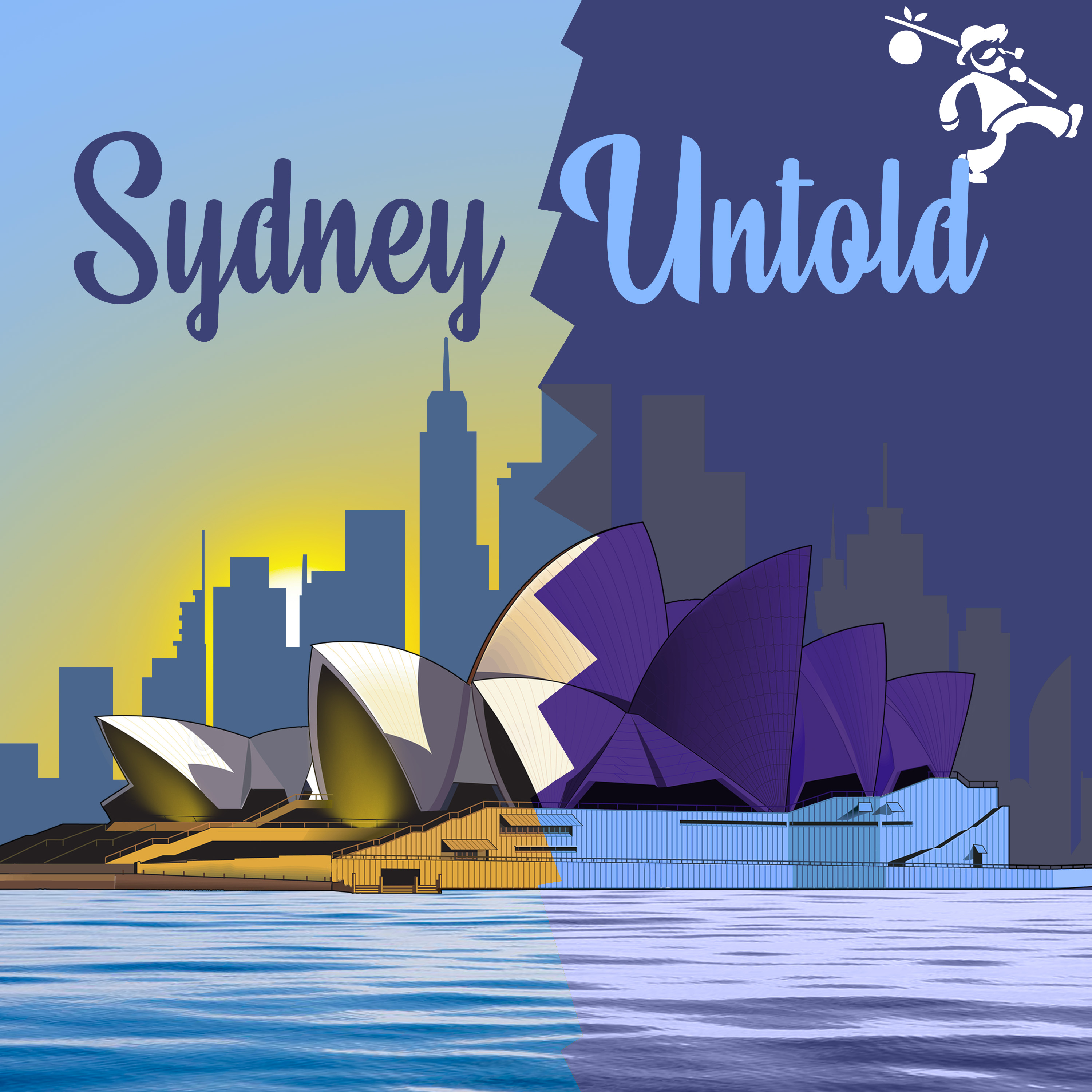Forgotten Songs - Forgotten Tank Stream Underneath
Thank you for listening to Sydney Untold!
This episode was about the Forgotten Songs installation and the tank stream that runs below it.
Forgotten Songs is an art installation located at Angle Place near Wynyard Station in Sydney's CBD. It is a reminder of the bird species that once lived in the city before Sydney was built.
The episode also explores the forgotten history of the Tank Stream, one of Sydney's original freshwater sources.
---
Host/Producer/Writer/Editor: Harry Hughes
Associate Producer: Adam Hughes
Special Tanks to Michael Hill, the Artist behind Forgotten Songs
Important Links
Podcast Website: https://sydneyuntold.hobohutmedia.com
Main Website: https://hobohutmedia.com
Instagram: https://instagram.com/hobohutmedia
Facebook: https://facebook.com/hobohutmedia
References:
Citations are sexy, here are links to everything we talked about in this episode.
Transcript
A hobohut media production.
Speaker:Every city has its secrets and Sydney is no exception.
Speaker:Welcome to Sydney Untold, a podcast about uncovering Sydney's hidden locations and history.
Speaker:From abandoned tunnels to secure cook gardens to even the most haunted road in the world, let's step back in time as we uncover some Sydney's secret pass.
Speaker:Living in Sydney, you can easily get caught up in the chaos of everyday life.
Speaker:Going to work, seeing friends, or what to have for dinner.
Speaker:Tonight, it's quite easy to forget about the beauty of nature in this concrete jungle that is Sydney's.
Speaker:CBD taking a short walk from Town Hall towards Winyard reveals a location that is a reminder of what once was.
Speaker:As you approach the recital hall at Angel Place, you begin to hear nearby restaurants.
Speaker:But if you listen a little closer, you can hear the sounds of birds that once occupied Sydney.
Speaker:Just above your head, hanging within a nearby alleyway, there are a collection of old bird cages, the site of Forgotten Songs.
Speaker:Forgotten Songs is an installation of 120 bird cages in Angel Place in Sydney.
Speaker:This is Michael Hill.
Speaker:He is the artist who made Forgotten Songs.
Speaker:He's also responsible for the lightbased work in Green Square Plaza, which is an Led pillar that graphically interprets the local weather.
Speaker:Forgotten Songs is an installation artwork located in the alleyway next to the iconic Angel Placeless Idle hall, which is home to some of Sydney's best live music and performance events.
Speaker:And it plays back the sounds of 50 bird species that used to live in that area before the arrival of Europeans.
Speaker:We often think about the way that or the way the city has grown up and we often think about the visual effect of cities, but this was focusing on the audio effect, what's missing from the audio soundscape with the arrival of the city.
Speaker:And one of those things is birdsong.
Speaker:So we're looking at all of those bird species that used to live in the city.
Speaker:It was first installed in 2009 as a temporary installation as part of the Laneways temporary project.
Speaker:Within the Laneways project, there were a number of different sites offered up by the city, different Laneways, around the centre of Sydney and down towards Circular Key.
Speaker:And we originally like the idea of Bridge Lane down towards Circular Key, kind of had this coffee sort of Lane way and we thought that would be a good place to hang the cages.
Speaker:But then as we started to talk to them and realized we were one of the shortlisted candidates, they suggested using Angel Place because it already had these existing anchors in the walls and it made it an easy install.
Speaker:So without having to kind of pay somebody to drill into the wall and hang bolts and get it all properly engineered, we could rely on anchors that are already there.
Speaker:The site of Forgotten Songs was picked and construction started.
Speaker:But did you know that below that site is another part of Sydney's history that was forgotten.
Speaker:The tank stream.
Speaker:The freshwater supply at Sydney Cove.
Speaker:Used by Europeans who first came to Australia and Australia's First Nations people long before them, it flowed north from a swampy high ground located within what is now Market Park and Elizabeth streets.
Speaker:With a catchment area totaling 161 acres.
Speaker:Composing roughly the size of the CBD, it entered Sydney Cove at what is now the intersection at Bridge and Pitt Street.
Speaker:It was surrounded by Sydney red gums banksias, waddles cabbage, tree palms and tree ferns and was, of course home to the bird species remembered in the Forgotten Songs installation.
Speaker:So what happened to the tank stream that once flowed into Sydney Cove? Well, like many things of yesteryear, it was a victim of ignorance.
Speaker:While clearing the area for housing, the first Europeans didn't realize that removing trees and underbrush moved the topsoil which kept the moss, ferns and undergrowth in their moist state.
Speaker:And within two years the water had become polluted.
Speaker:Following that, the construction was banned surrounding the river and tanks were built.
Speaker:Hence how it got its name as a last ditch effort to save the remaining stream.
Speaker:But the damage was done and in 1826 the tank stream was no longer being used as a water source, being replaced by an underground channel that brought water from lachlan swamps in Centennial Park to a reservoir in Hyde Park.
Speaker:As there was no need to retain what was left of the stream, the surrounding land was sold and developed and became an underground stormwater dream.
Speaker:The system of tunnels through which the tank stream flowed still exists today, taking away the excess water from Sydney streets.
Speaker:In 1981, the city of Sydney commissioned Sydney artist Stephen Walker to design a sculpture called the TankStream Fountain.
Speaker:It was built at Circular Key near where the light rail stop is currently located.
Speaker:It depicts the floor and fauna that once populated the banks of the tank stream.
Speaker:It is a reminder of what used to be just like the Forgotten Songs installation at Angel Place.
Speaker:Well, the genesis of it was a conversation I had with an ornithologist from the Australian Museum, Dr.
Speaker:Richard Major.
Speaker:And I was working on a video project with him where he was tagging white ibis and as we know, they're one of the great survivors in the city and they love human habitation.
Speaker:But meanwhile there are these other birds that aren't great survivors, he said, and they've had to make their livings elsewhere.
Speaker:And it was the smaller songbirds that needed kind of thorny bushes and needed protection from predators and the right food sources to be able to survive.
Speaker:And all of those things have wild and all being decimated by cities.
Speaker:The Soundscape has two different modes one for the day and one for the night.
Speaker:We wanted some daytime birds and then we wanted this soundtrack to also play back at night.
Speaker:So we wanted the nighttime birds, the boobowls and those sorts of things the night.
Speaker:Charles so in discussing it with Richard Major, he said the best way to do it was, well, there's a couple of paths he took.
Speaker:One was to look at the soil types around Angel Place.
Speaker:And so being by the creek and the kind of soil type that would have existed there, he was able to extrapolate on there the kinds of trees that would have lived there and the kind of brush and so the kinds of birds that favored that sort of vegetation.
Speaker:So he made up this list and then compared it also with a whole lot of skins of birds from the Australian Museum.
Speaker:So there's a big collection of birds that have been collected all over the city, reaching back 150 years or so.
Speaker:So he's able to determine that, yes, these actually did live here or might have been gathered at this point.
Speaker:The aim was to make the work sound dynamic, so you could visit the installation multiple times, even at different times of the day, and it would sound different.
Speaker:Ultimately, the project is based on a loop, but there's five different can be three players and they kind of play out of phase with each other, so that it's not exactly kind of a loop that you notice.
Speaker:You want it to be able to be impressive for people who hear it the first time, but also for those that make it part of their regular commute.
Speaker:You want it to always be slightly changing.
Speaker:So we wanted to have a different character in the night than the morning, without it being kind of strange and lonely and spooky with too many owl noises and a few other things still make it sound fairly friendly and fairly alive.
Speaker:Due to its massive popularity in 2011, the city of Sydney, as part of a $9 million laneway development, forgotten Songs was converted to become permanent.
Speaker:So we were able to do a version of the project within the limited budget using a lot of secondhand cages we found on the street or off ebay or we had these filthy old bird cages that we had to clean up and then put in the soundscape and hung them in the lane way.
Speaker:But then when it came time to making it permanent, we were advised by the engineers that plastic in the cages would be affected by UV and rotten fall off and then all the rusty parts would all fall down on top of people.
Speaker:So we had to work out ways of making it for the long term.
Speaker:So we used a lot of brass cages and stainless steel, and some were specially made.
Speaker:So it became a lot more of a robust installation and it was a different set of questions.
Speaker:When you start to think about it having to last for 25 years rather than three months, it's got this slightly more robust look but we still like the character of it and still got the slightness to it that the original version had.
Speaker:So next time you're strolling through the city and you find yourself in the Angel Place, take a moment to stop and listen.
Speaker:In the hustle and bustle of daily life, it can be easy to forget what has come before these city streets, but reminders of rich life that used to lay beneath our feet can ensure these songs do not remain forgotten.
Speaker:Thank you for listening to this episode of Sydney Untold.
Speaker:I hope you've enjoyed learning about Forgotten Songs installation at Angel Place and the forgotten history of the TankStream.
Speaker:I'd like to thank Michael Hill, the artist behind Forgotten Songs, for appearing in this episode and for Green to talk about his work.
Speaker:This episode of Sydney Untold was hosted, written, produced and edited by Harry Hughes.
Speaker:And thank you to our associate producer Adam Hughes.
Speaker:Hobohart Media Group would like to acknowledge the Aboriginal people of the war and land and the ghetto people past and present, the location of which this episode is located.




